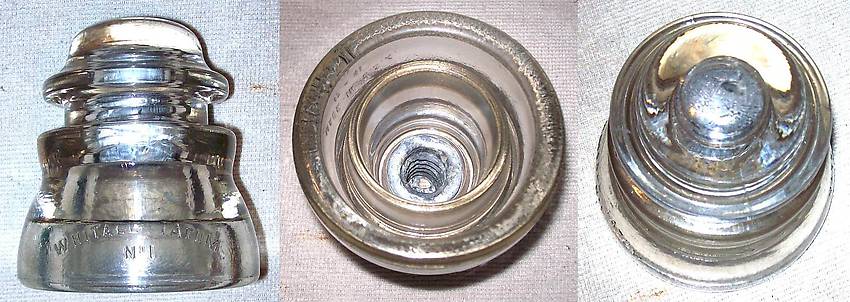
Picked this up at an antiques mall only because I've never seen one of these metal inserts or thimble in the pinhole of anything but a CD 128/129 style. The specific embossing is EIN [005] (F-Skirt) (Arc) WHITALL TATUM / No 1 (R-Skirt) (Arc) MADE IN U.S.A. / 17 - 41 / A [in a circle] SB. Anyone seen this before? What is the purpose? UPDATE: Several folks responded with a number of theories, including: "I have seen this done when the insulators that the storeroom had plenty of were the wrong size pin hole for the pins in the location that the insulator was needed. The insert was called in my storeroom a pinhole adaptor. Said adaptor would allow the phone man to use a standard thread pinhole insulator on a small pin. I have several smaller insulators with the same adaptor insert." "It looks like someone poured babbitt metal around a carrier circuit pin placed in the pinhole so they could use the insulator on a carrier circuit! I don't think WT would have done that in house, since they offered their own styles of carrier circuit insulators, but I can't say that with absolute certainty." "Two possibilities: That's an adapter to convert wood-pin threads to the carrier-style pin. Someone installed this on a lead-head pin (typically used with mud) and when it came down, whoever salvaged the insulator twisted the steel portion of the pin out, leaving the lead bit stuck in." "That small style threading was used on toll leads." "It may be one for export with a foreign thread adapter. The date code looks like early war production for the Allies although we were not directly involved until December 1941." And the most likely, in my opinion: "Looks like an adapter to a carrier circuit type pin like the 128s you mention. I'd guess your idea about them being similar to 128s is essentially right - it was an attempt to put a 155 on a carrier circuit line, or to use carrier-type pins elsewhere. Given that WT made 128s, it's not unreasonable to think they may have experimented with other designs to see if they could meet the controlled impedance requirements of such circuits. Another option would be so that the same pins could be used on the whole pole, but only some pairs would be CCs, whereas others would be just conventional voice or power." Thanks a lot for the suggestions Mark, Richard, David, Jack, Dave, and Nathan. |